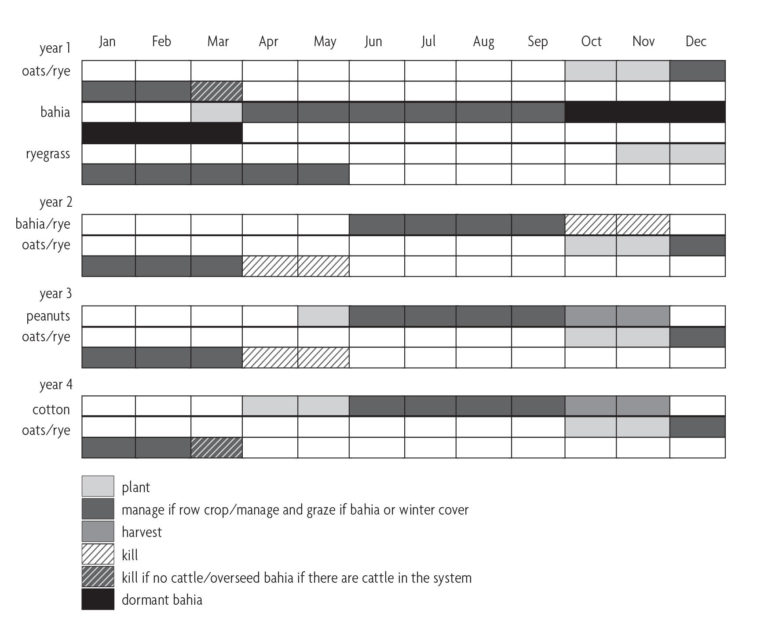David L. Wright, University of Florida
James J. Marois, University of Florida
Cheryl L. Mackowiak, University of Florida
Duli Zhao, USDA-ARS
Sheeja George, University of Florida
Cliff Lamb, University of Florida
Agriculture in the United States followed the European model of integrating livestock and row crops until the mid-20th century when mechanization and specialization caused farmers to separate these enterprises. Reintegrating livestock and sod into row-crop rotations is being evaluated now because perennial grass (sod) in a rotation has beneficial effects on soil, water availability, crop productivity, pest control and risk management. Because profit margins for most crops are slim, it is difficult for growers to consider farming practices that do not maximize yields and economic returns. A diversified system with a rotation of perennial grass, livestock grazing, row crops and winter cover crops can improve farm profitability and reduce the risks associated with climatic extremes and crop price fluctuations [40, 48].
Although there are many advantages to a sod-based rotation, currently there is not widespread adoption. On rented land, producers have little incentive to put fields into perennial grass for two to three years because of the loss of income. Additionally, the lease may be lost when another farmer sees the “layout” of the sod-based rotation and offers a higher rent. On row-crop farms, opportunities for grazing are limited since much of the land is not fenced. Higher crop yields and lower pest pressure are expected on land in a sod-based rotation, but there is little information showing the economic benefit of keeping perennial grass in the rotation after the land is put into row crops.
This chapter analyzes a rotation with bahiagrass, livestock grazing, cotton, peanuts and winter cover crops as depicted in Figure 8.1. The economics and risk management of the rotation are compared to a short-term rotation and a standard rotation used in a conservation tillage system. Short-term rotations alternate peanuts and cotton with winter covers: peanuts>winter cover>cotton>winter cover. A standard conservation tillage rotation in this analysis refers to one year of peanuts followed by two years of cotton with winter covers: peanuts>winter cover>cotton>winter cover >cotton>winter cover. The sequence of events in a short-term rotation is the same as the last two years of the sod-based rotation in Figure 8.1. The sequence of events in a standard conservation rotation is the same as the last two years of the sod-based rotation plus another year of cotton. Research results concerning variations of these rotations are also described in the chapter.
All the rotations discussed in this chapter use conservation tillage practices. The soil is covered throughout the year with perennial grass and/or an oat or rye winter cover crop. Winter cover crops always follow row crops. When bahiagrass is grown, the winter cover crop is overseeded into the dormant bahiagrass. Bahiagrass is dormant from October through March.
Row crops are strip-tilled into terminated sod or winter cover crop residue. Sod and cover crops are planted using a grain drill. If cattle are in the system, the winter cover crop is killed only three to four weeks before planting peanuts or cotton.

